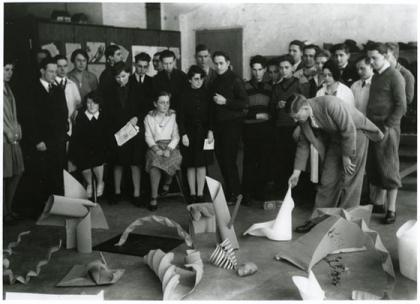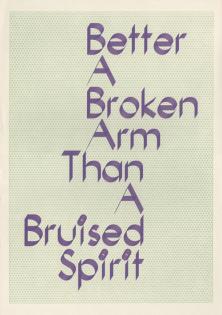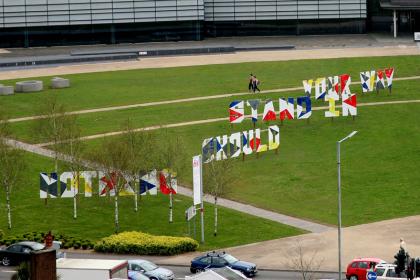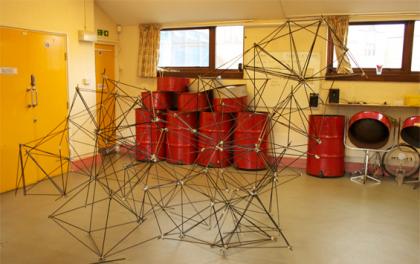Simon & Tom Bloor and Hermitage Primary School, Wapping, London
Gathering Experience
’We do not always create ’works of art’, but rather experiments; it is not our ambition to fill museums: we are gathering experience’Joseph Albers.[1]

Recently I attended Bauhaus: Art as Life at the Barbican Gallery[2] and was struck by the genuinely collaborative and interdisciplinary locus of learning the Bauhaus had been - with students working together on everything from homemade birthday cards and costumes for musicals staged at the school, to furniture and architectural designs. Photographs of the students in the exhibition spoke of the Bauhaus’ unique environment for learning, where work and play were interchangeable, and the importance of experimentation and collaboration (instead of competition) was crucial. Joseph Albers encapsulated this philosophy in his words above, and believed that learning how to invent through the process of discovery was the basis of ’training for every kind of design’, beginning by working with the material in a ’purposeless, playful’ way with the hands.[3] This made me think not only of the artwork and approach of Simon and Tom Bloor, with whom I’ve been working with for the past year on one of the Whitechapel Gallery’s Artists in Residence in Schools programmes at Hermitage Primary School[4], but also the kind of environment that needs to be created to make this kind of programme have maximum impact among the children who participate. With this ideal in mind, the following case study considers, from the points of view of the 3 different perspectives involved - the artists, the school and the gallery, how a creative, collaborative and experimental environment can be arrived at in a school.
’Better a Broken Arm than a Bruised Spirit’

When considering the impact and effect of an Artist in Residence programme on a school and the children involved, ’Better a broken arm than a bruised spirit’, a quote from Simon and Tom Bloor’s print work of 2009 came to mind. Inspired by Lady Allen of Hurlwood (1897-1976), a pioneer of adventure and ’junk’ playgrounds who wrote extensively about post war children’s playgrounds and asserted the importance of adventure and risk over preventative health and safety laws, the quote represents the Bloors’ thinking on children’s play. Twin brothers born in 1973 in Birmingham, the Bloors live and work in London and Birmingham.[5] Currently, they are working on a large-scale public art project developing embedded ’Art & Play’ sculptures in new developments in London and Cambridge, that encourage informal play and interaction for all ages[6].

The artists work in a variety of materials and formats - from drawings and sculpture to installation and public art. Much of their work is inspired by found images and existing texts gleaned from a variety of sources which are appropriated and re-presented ’combining a ’design’ sensibility with lo-fi materials, simple processes and pop production values’[7]. Never having worked in a primary school before, the opportunity to work at Hermitage Primary School was seen as a challenge for the Bloors, and an opportunity to engage not only with the central concerns and starting points of their practice, but with more diverse ways of thinking in a school environment, from both the artists’ and children’s points of view. From the outset, a key aim for the artists was to expose children to skills and activity outside the formal Art & Design Primary Curriculum, to get them to start thinking differently about the meaning of art, in an abstract way and on a large scale, together. They wanted to ’experiment with production, and develop new ideas for playful, useful art’[8]. Their approach was influenced by the philosophy and books of educationalists such as John Lidstone (’Working Big’, 1975) and Kurt Rowland (’Learning to See’, 1968), and was achieved through a variety of workshops in the first and second term linked to their practice. Growing progressively in scale and ambition as the year progressed, workshops included expansive collaborative constructions with sticks and elastic bands, 3D paper constructions inspired by the modernist mobiles, and patterns evolved from rubbings taken in the school yard.

The view from the school
A creative place, with titles of classrooms such as ’Ai Wei Wei’ and ’Mondrian’, Hermitage Primary is a school with an interest in the visual arts, which benefitted the residency from the outset. Residencies can create upheavals in schools to the usual rhythm of planning, timetabling and adhering to the curriculum, so the school had to be fully committed to the programme for it to work. Head Teacher Zoe Howe’s reasons for getting involved were that she wanted children to collaborate directly with professional artists, to get to know them as people and for their curiosity to be peaked in a way that it wouldn’t usually. Teachers involved wanted the residency to challenge children’s concepts of what art was, and to push the boundaries of what they usually do in the classroom. Outcomes were important for the school, such as a chalkboard with colourful geometric designs created by the artists in consultation with a group of children from the school; a Plydome created that was displayed for a Parents’ Evening; and clay pieces moulded by students that will eventually be cast in chalk, and which will form part of an exhibition at the Whitechapel Gallery. Overall, a wider engagement with families from the school by the Whitechapel Gallery and a lasting legacy of access to the visual arts were major objectives of the programme. This aim was enhanced through additional ’After School Club’ activities and contributions to the school bulletin undertaken by Support Artist Ella Phillips (who also documented the programme), visits to the Whitechapel Gallery with the artists, and by linking the family programme at the Gallery with the residency as much as possible.

The Gallery’s role
The Gallery’s role is key in relation to counteracting the degree of the unknown when it comes to working with artists in schools. As mentioned, it can be a new environment for the artists and a new experience for the schools; and no matter how much good will is present at the outset, the meeting of independent professional artists who have their own motivations for undertaking residencies at schools, with public schools that are hardwired to adhere to established curricula and physical outcomes, can be tricky. The Gallery needs to ensure that communication is flowing consistently and that both parties are achieving what they want and need from the residency. Much of the unknown can be counteracted at the outset with clear aims and a framework for how the residency will work planned in consultation with all parties. The framework needs to be extremely tailored, but also flexible as the year goes on, and responsive to discoveries made by the artists or objectives identified by the school. Evaluation is also the role of the Gallery. For Simon and Tom’s residency, evaluation was continual, in the form of documentation, feedback at meetings, and interviews with artists, teachers and children that fed into the final film created by support artist Ella Phillips. Final evaluation occurred between all parties involved, and identified many aspects that may alter the future progression of the Primary School Residency at the Whitechapel Gallery:
- Planning: More advance planning and further communication and evaluation meetings organised by the Gallery and artists could have counteracted the lack of information that teachers often had about artists’ workshops in advance, preventing curricular links being made. In future residencies, the school curriculum will be shared with artists, and any overlap in terms of themes or skills identified early on in the process.
- Structure: Rather than the fortnightly engagement of one day that was pursued by the artists and Gallery, shorter blocks of time where artists worked consecutive days will be explored. The Bloors’ work could have become more embedded in the school if this had happened, and the artists felt they were only skimming the surface at times, preferring more intense periods of working at the school with smaller focused groups.
- Studio space: Although a noticeboard was continually visible about the project and artists increasingly created work with children that was seen by parents, both the school and artists noted that somewhere permanent and outwardly visible in the school for the artists to use as a studio and store materials would have benefitted the project; creating a consistent visibility in the school.
- Exhibition: Similarly, holding an exhibition of the fruits of the collaboration at the Gallery within the school year would have been a desirable in relation to visibility and connecting the residency with the Gallery. (The exhibition is scheduled for December 2012 - March 2013).
Martin Rewcastle, the Whitechapel Gallery’s first Education Officer, initiated the Artists in Schools programme for the Gallery in 1978, following a conference he organised looking at American models of this kind of activity (where it had been happening since the 1960s). Its continued presence in the programme (albeit with different iterations and different focuses over time), shows a commitment to this kind of activity at the Gallery. An in-depth, long-term relationship with schools in the Gallery’s borough, Tower Hamlets and neighbouring boroughs in London is important for the Gallery in order to keep in touch with the local audience for exhibitions and events on its doorstep in a consistent and effective way. The Gallery, as a resource for modern and contemporary art in the area, is interested in putting schools in contact with professional artists who have an interest in the environment of the school and want to bring new ways of looking at and making art into the classroom. This not only benefits children in terms of experiencing vastly different teaching styles and different types of role models, but can enhance critical thinking and visual analysis skills, while giving children the opportunity to achieve something with other children outside of the curriculum and where the focus is, in general, on ’gathering experience’, as the Bauhaus put it. Partnerships like the Bloor/ Hermitage one, brokered by the Gallery, continue to happen and to work for many different reasons, but the core of why they work and the energy that drives them is the ’similar enthusiasm among children that artists get from engaging with art’[9].
Jean Tormey
Jean is currently Curator: Schools & Families at the Whitechapel Gallery, London.
[1]Joseph Albers was a furniture designer and educator who was a student and master at the Bauhaus School. Taken from Bauhas: Art as Life Learning Resource written by Emma Ridgway, Creative Learning Curator, and Cathy Haynes, independent curator and educator.
[2]Bauhaus: Art as Life took place at the Barbican Art Gallery, London from 3 May 2012 - 12 August 2012.
[3]Bauhas: Art as Life Learning Resource.
[4]Hermitage is a one-and-a-half form entry primary school located in Wapping, East London with about 270 children on roll ranging from nursery (age 3) to year 6 (age 11). It is located close to the River Thames and St Katharine’s Docks.
[5] Founding Directors of Eastside Projects, Birmingham, the Bloors have exhibited widely in the UK and Europe, Canada and the US and have developed 2 publications - As Long as it Lasts (Eastside Projects, 2009) and Something to do and Somewhere to do it (Modern Art Oxford, 2010), a book in the form of a children’s drawing book.
[6]The commission in London combines their interest in ’the history of public art, a take on natural play scape features and an updated version of Victorian artificial rock features to create a bronze and concrete climbing sculpture and series of stepping stones’; and the other references Aldo Van Eyck’s (architect from the Netherlands) ’inbetweening’ approach of ’using left-over spaces, and opportunities for ’incidental play’ - thus the artists have proposed zigzags in footpaths, bollards for leapfrogging, slopes for climbing and areas for chalk drawing. Art and Playgrounds by Simon and Tom Bloor, an interview with Paige L. Johnson from Playscapes - A Blog about Playground Design, Thursday July 19, 2012.
[7]Simon and Tom Bloor, from description of their own work in email communication, 2012.The Bloors’ work has the ability to unearth forgotten sociological and educational histories, arriving at new meanings and alternative interpretations of these histories, whether it is about modernist public sculpture or playgrounds and urban play as a utopian pursuit. See http://www.simonandtombloor.com/.
[8] http://www.whitechapelgallery.org/education/schools/artists-in-residence/previous-residencies/201112-simon-and-tom-bloor.
[9] Simon and Tom Bloor, quote from Ella Phillips’ film about residency.


No comments added